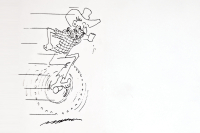Burning down the house
An Arsonist’s Guide to Writers’ Homes in New England by Brock Clarke. Algonquin Books, 2007. 305 pages.
Some writers come to seem like friends to their readers, even like family. Oddly enough, in my own case these writers are not my favorite authors. I still cherish the work of Hemingway, but the more I read about the man, the possibility that I might have enjoyed dining with him diminishes. In regard to an author like James Jones, however, I treasure only one or two of his works — From Here to Eternity, and possibly his World War II history — but from what I have read of the man breaking bread together would have been a pleasure.
Then there are the few authors who claim our affections both by their work and by the quality of their lives. For me, one such artist is John Gardner. Gardner, who died some 20 years ago in a motorcycle crash, wrote such great books as Grendel, The Sunlight Dialogues, October Light, and Mickelsson’s Ghosts. While writing his novels and short stories, he also taught fiction in various universities, partied like a wild man, and offered counsel to scores of budding writers.
Thirty years ago, Gardner wrote On Moral Fiction, a critique of current writing that even today produces admiration and anger in writers and readers. Not only did Gardner throw buckets of cold water on some of the sillier novelistic trends of the time, but he also negatively criticized specific contemporary authors — Stanley Elkin, John Updike, Robert Coover, and others — a tactic that left Gardner’s own subsequent writing open to vicious counterattacks, particularly from the New York critics who at that time still dominated the world of letters.
One aspect of modern fiction — and by extension, we may add contemporary plays and motion pictures — Gardner deemed immoral is the frequent triumph of form and style over substance, and the consequent abuses of such a triumph. In On Moral Fiction, he writes, “To learn about reality by mimicking it, needless to say, the writer must never cheat. He my establish any sort of givens he pleases, but once they are established he must follow where, in his experience, nature would lead if there really were, say, griffins.” Gardner is saying, in other words, that a movie or book that establishes certain premises regarding its characters becomes a lie and a cheat if the creator has the characters act contrary to their own nature.
The more fiction I read, the more movies I see, the more I become aware how much Gardner’s idea gains in truth and significance. Who has not seen movies in which the protagonist acts contrary to his own character, or worse, in which some sort of deus ex machina appears to rescue the plot from itself? Who has not read a book in which one or more of the characters does something so unnatural, so contrary to his own created personality, that it destroys the unity of the story? (Gardner himself gave a brilliant send-up of this trend in October Light, a novel telling two parallel stories, one realistic and natural, the other plastic and illogical).
Brock Clarke’s An Arsonist’s Guide to Writers’ Homes in New England (ISBN 13 978-1-56512-2551-3, $24.95) promises many literary treats to its readers. The title is catchy; a blurb on the cover describes this book as “a literary tour de force — a brilliant skewering of every memoir ever written and a novel that will have readers underlining their favorite passages and reading them aloud.” And when we enter An Arsonist’s Guide, we immediately meet an engaging narrator, Sam Pulsifer. Sam has served time as a teenager and young adult for burning down the Emily Dickinson house in Amherst, Mass. He goes to college after his release from prison, meets a young woman he loves, marries, fathers two children, and seems to live an idyllic life until Thomas Coleman, the young man whose parents died in the fire, shows up on Sam’s doorstep. From that point on, Sam’s life takes a downward turn. He and his wife separate, he loses his job, he discovers secret after secret about his parents’ marriage (His father, who is connected to the literary world as an editor, sees his own house and life go up in flames). Sam spends a good deal of his time tracking down the arsonist who is burning the houses of other authors — the Bellamy house, the Twain house — while trying to reconcile himself to the damage done by his own parents.
Unfortunately, the actions of the characters in An Arsonist’s Guide are themselves so out of character, indeed in some cases, so illogical, that the story slowly self-destructs. Early on in the novel, for example, Sam describes his courtship and marriage to Anne Marie. While the wedding is being planned, Anne Marie asks Sam why his parents aren’t coming. He lies and tells her that his parents died when their house burned down. Even the most cursory reading of such a passage raises alarms. Are we really supposed to believe that Anne Marie, who has retained her own family ties, would wait until the wedding to ask Sam questions about his own mother and father? And further on in the novel, when Sam tells us about some postcards his mother showed him as a boy regarding his father’s activities, are we — or for that matter, Sam — really supposed to believe that the father in a three-year period played at so many professions, everything from an emergency room surgeon in the Rockies to a funeral director in Florida, from a pediatrician in Michigan to an air traffic controller in Newark? Though such claims eventually reveal themselves as lies, surely someone as astute as the older Sam could have figured these out as false.
Other incongruities occur throughout the novel. We are asked to believe that Sam’s parents maintained an arrangement involving his father’s mistress for all these years, but are never given the reasoning behind such an arrangement. We are told that Sam’s mom told many stories about the Emily Dickinson house, thereby possibly leading Sam to burn it down, but we’re never really told the stories in any detail. We’re supposed to believe that Sam can’t tell his wife about his arson and subsequent prison sentence, and yet he seems positively garrulous when discussing his life with anyone else.
And so it goes: another stylish book whose many charms fail to seduce us into the fictional dream.





